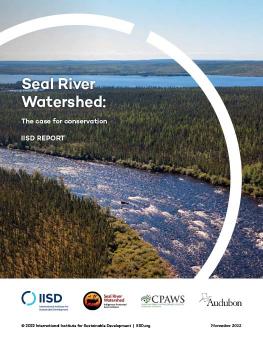
Seal River Watershed: The case for conservation
The Seal River Watershed Indigenous Protected Area (IPA) Initiative is an Indigenous-led conservation project that aims to establish a protected area under the active stewardship of Indigenous Peoples. This report presents an overview of the value of the Seal River Watershed, including its environmental, social, cultural, and economic value, and discusses the significance of protecting it for future generations. The report further lays out the benefits and considerations for establishing the Seal River Watershed IPA in Manitoba based on existing Canadian examples.
-
Canada and Manitoba are unlikely to meet or scale up their conservation targets without the support and involvement of Indigenous communities.
-
The Seal River Watershed provides important benefits to Manitobans and the world, ranging from habitat for threatened species to sustaining the cultures of Indigenous Peoples and promoting Northern tourism.
The Seal River Watershed is located in northern Manitoba, Canada, and encompasses an area of 50,000 km2, nearly 8% of the province. Due to its remote, pristine environment, the watershed holds immense value from environmental, cultural, social, and economic perspectives, including:
- Biodiversity: The watershed is home to an estimated 250 bird species and at least 350 species of other taxa, including 48 mammal species.
- Carbon storage: It stores an estimated 1.7 billion tonnes of carbon, equivalent to 6.2 billion tonnes of CO2, valued at CAD 314.5 billion.
- Indigenous culture: The pristine nature of the watershed allows members of the Sayisi Dene First Nation, Northlands Denesuline First Nation, Barren Lands First Nation, and O-Pipon-Na-Piwin Cree Nation to maintain a connection to their culture and identity.
Establishing the Seal River Watershed IPA presents a unique opportunity to protect this important ecosystem for future generations and for the Indigenous communities to share their Traditional Knowledge, history, and culture with visitors from Canada and around the world.
To support the Seal River Watershed IPA Initiative, the government of Manitoba can:
- Adopt interim measures to protect the watershed from commercial resource extraction and development.
- Establish a Seal River Watershed IPA committee or working group to undertake a feasibility study and identify provincial legislative options for establishing an accompanying Crown designation for the watershed.
- Provide in-kind technical and communications support for the Seal River Watershed Alliance, partner nations and organizations.
You might also be interested in
For Nature-Based Solutions to Be Effective, We Need to Work with Indigenous Peoples and Local Communities
Nature-based solutions have been praised as a promising approach to tackling the twin crises of climate change and biodiversity loss. But some Indigenous Peoples and local communities are questioning the legitimacy of the concept and what it symbolizes. It is time to listen to what they have to say.
How Can We Work With Nature to Tackle Drought and Desertification?
Drought is one of the most devastating and pervasive challenges exacerbated by climate change. However, we can work to reduce its effects through nature-based solutions for land restoration and climate-smart agriculture.
Powering the Clean Energy Transition: Net-Zero electricity in Canada
This brief explains how a shift to clean power generation can offer affordable, reliable electricity, benefiting households and businesses alike.
COP 29 Outcome Moves Needle on Finance
In the last hours of negotiations, concerted pressure from the most vulnerable developing countries resulted in an improved outcome on the finance target, with a decision to set a goal of at least USD 300 billion per year by 2035 for developing countries to advance their climate action.